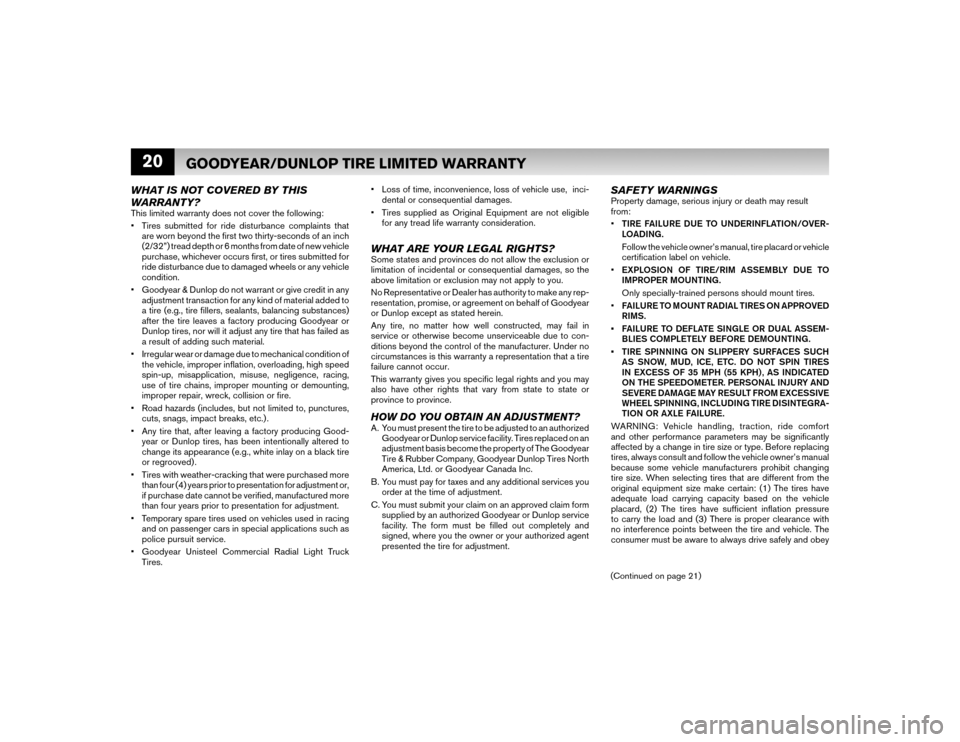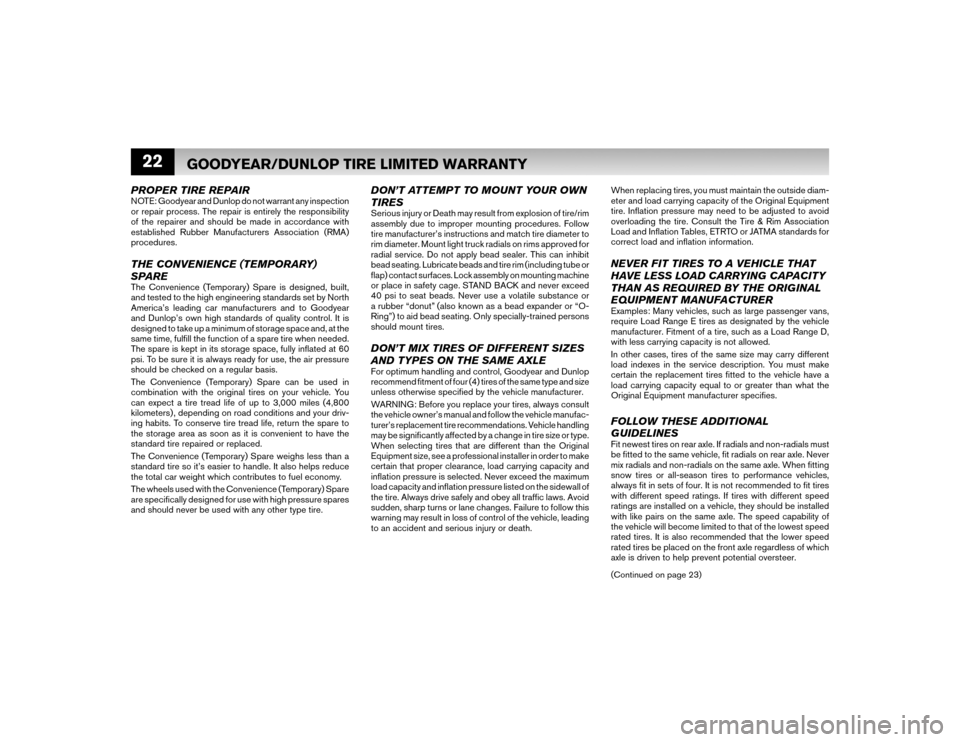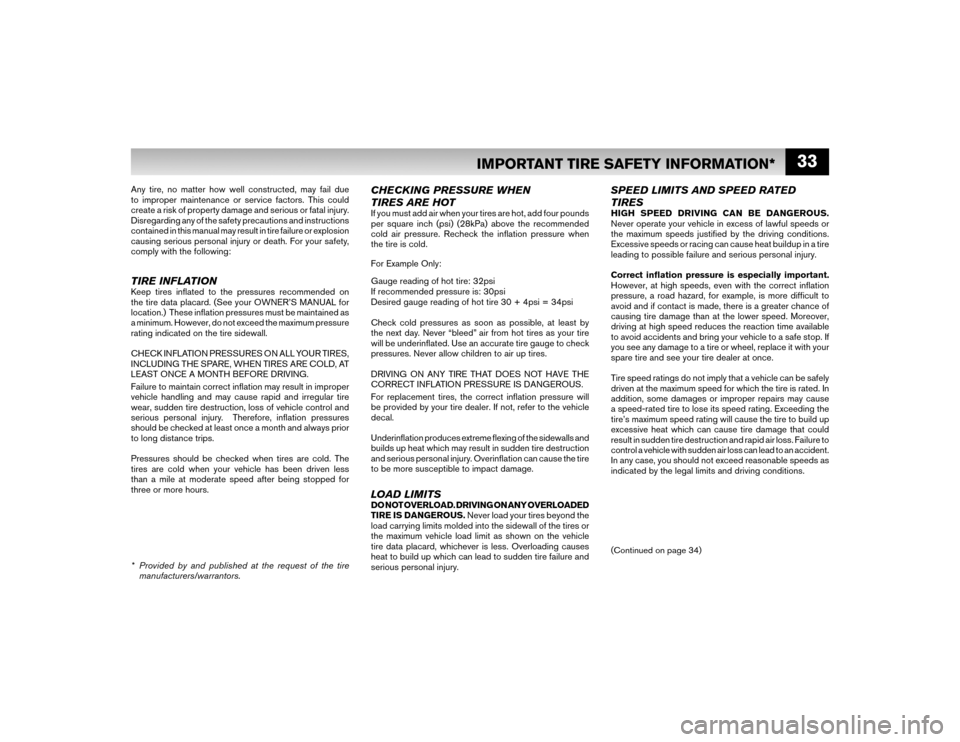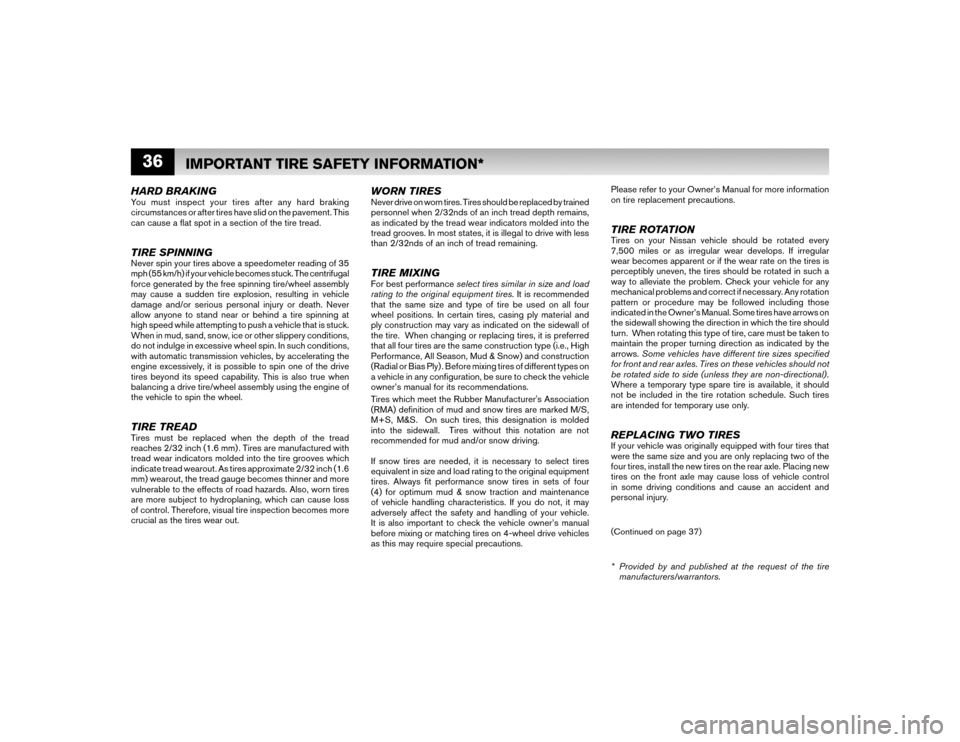2009 NISSAN VERSA HATCHBACK four wheel drive
[x] Cancel search: four wheel drivePage 23 of 55

20
GOODYEAR/DUNLOP TIRE LIMITED WARRANTY
WHAT IS NOT COVERED BY THIS
WARRANTY?This limited warranty does not cover the following:
• Tires submitted for ride disturbance complaints that
are worn beyond the fi rst two thirty-seconds of an inch
(2/32”) tread depth or 6 months from date of new vehicle
purchase, whichever occurs fi rst, or tires submitted for
ride disturbance due to damaged wheels or any vehicle
condition.
• Goodyear & Dunlop do not warrant or give credit in any
adjustment transaction for any kind of material added to
a tire (e.g., tire fi llers, sealants, balancing substances)
after the tire leaves a factory producing Goodyear or
Dunlop tires, nor will it adjust any tire that has failed as
a result of adding such material.
• Irregular wear or damage due to mechanical condition of
the vehicle, improper infl ation, overloading, high speed
spin-up, misapplication, misuse, negligence, racing,
use of tire chains, improper mounting or demounting,
improper repair, wreck, collision or fi re.
• Road hazards (includes, but not limited to, punctures,
cuts, snags, impact breaks, etc.) .
• Any tire that, after leaving a factory producing Good-
year or Dunlop tires, has been intentionally altered to
change its appearance (e.g., white inlay on a black tire
or regrooved) .
• Tires with weather-cracking that were purchased more
than four (4) years prior to presentation for adjustment or,
if purchase date cannot be verifi ed, manufactured more
than four years prior to presentation for adjustment.
• Temporary spare tires used on vehicles used in racing
and on passenger cars in special applications such as
police pursuit service.
• Goodyear Unisteel Commercial Radial Light Truck
Tires.• Loss of time, inconvenience, loss of vehicle use, inci-
dental or consequential damages.
• Tires supplied as Original Equipment are not eligible
for any tread life warranty consideration.
WHAT ARE YOUR LEGAL RIGHTS?Some states and provinces do not allow the exclusion or
limitation of incidental or consequential damages, so the
above limitation or exclusion may not apply to you.
No Representative or Dealer has authority to make any rep-
resentation, promise, or agreement on behalf of Goodyear
or Dunlop except as stated herein.
Any tire, no matter how well constructed, may fail in
service or otherwise become unserviceable due to con-
ditions beyond the control of the manufacturer. Under no
circumstances is this warranty a representation that a tire
failure cannot occur.
This warranty gives you specifi c legal rights and you may
also have other rights that vary from state to state or
province to province.HOW DO YOU OBTAIN AN ADJUSTMENT?A. You must present the tire to be adjusted to an authorized
Goodyear or Dunlop service facility. Tires replaced on an
adjustment basis become the property of The Goodyear
Tire & Rubber Company, Goodyear Dunlop Tires North
America, Ltd. or Goodyear Canada Inc.
B. You must pay for taxes and any additional services you
order at the time of adjustment.
C. You must submit your claim on an approved claim form
supplied by an authorized Goodyear or Dunlop service
facility. The form must be fi lled out completely and
signed, where you the owner or your authorized agent
presented the tire for adjustment.
SAFETY WARNINGSProperty damage, serious injury or death may result
from:
• TIRE FAILURE DUE TO UNDERINFLATION/OVER-
LOADING.
Follow the vehicle owner’s manual, tire placard or vehicle
certifi cation label on vehicle.
• EXPLOSION OF TIRE/RIM ASSEMBLY DUE TO
IMPROPER MOUNTING.
Only specially-trained persons should mount tires.
• FAILURE TO MOUNT RADIAL TIRES ON APPROVED
RIMS.
• FAILURE TO DEFLATE SINGLE OR DUAL ASSEM-
BLIES COMPLETELY BEFORE DEMOUNTING.
• TIRE SPINNING ON SLIPPERY SURFACES SUCH
AS SNOW, MUD, ICE, ETC. DO NOT SPIN TIRES
IN EXCESS OF 35 MPH (55 KPH) , AS INDICATED
ON THE SPEEDOMETER. PERSONAL INJURY AND
SEVERE DAMAGE MAY RESULT FROM EXCESSIVE
WHEEL SPINNING, INCLUDING TIRE DISINTEGRA-
TION OR AXLE FAILURE.
WARNING: Vehicle handling, traction, ride comfort
and other performance parameters may be signifi cantly
affected by a change in tire size or type. Before replacing
tires, always consult and follow the vehicle owner’s manual
because some vehicle manufacturers prohibit changing
tire size. When selecting tires that are different from the
original equipment size make certain: (1) The tires have
adequate load carrying capacity based on the vehicle
placard, (2) The tires have suffi cient infl ation pressure
to carry the load and (3) There is proper clearance with
no interference points between the tire and vehicle. The
consumer must be aware to always drive safely and obey (Continued on page 21)
Page 25 of 55

22PROPER TIRE REPAIRNOTE: Goodyear and Dunlop do not warrant any inspection
or repair process. The repair is entirely the responsibility
of the repairer and should be made in accordance with
established Rubber Manufacturers Association (RMA)
procedures.THE CONVENIENCE (TEMPORARY)
SPAREThe Convenience (Temporary) Spare is designed, built,
and tested to the high engineering standards set by North
America’s leading car manufacturers and to Goodyear
and Dunlop’s own high standards of quality control. It is
designed to take up a minimum of storage space and, at the
same time, fulfi ll the function of a spare tire when needed.
The spare is kept in its storage space, fully infl ated at 60
psi. To be sure it is always ready for use, the air pressure
should be checked on a regular basis.
The Convenience (Temporary) Spare can be used in
combination with the original tires on your vehicle. You
can expect a tire tread life of up to 3,000 miles (4,800
kilometers) , depending on road conditions and your driv-
ing habits. To conserve tire tread life, return the spare to
the storage area as soon as it is convenient to have the
standard tire repaired or replaced.
The Convenience (Temporary) Spare weighs less than a
standard tire so it’s easier to handle. It also helps reduce
the total car weight which contributes to fuel economy.
The wheels used with the Convenience (Temporary) Spare
are specifi cally designed for use with high pressure spares
and should never be used with any other type tire.
GOODYEAR/DUNLOP TIRE LIMITED WARRANTY
DON’T ATTEMPT TO MOUNT YOUR OWN
TIRESSerious injury or Death may result from explosion of tire/rim
assembly due to improper mounting procedures. Follow
tire manufacturer’s instructions and match tire diameter to
rim diameter. Mount light truck radials on rims approved for
radial service. Do not apply bead sealer. This can inhibit
bead seating. Lubricate beads and tire rim (including tube or
fl ap) contact surfaces. Lock assembly on mounting machine
or place in safety cage. STAND BACK and never exceed
40 psi to seat beads. Never use a volatile substance or
a rubber “donut” (also known as a bead expander or “O-
Ring”) to aid bead seating. Only specially-trained persons
should mount tires.DON’T MIX TIRES OF DIFFERENT SIZES
AND TYPES ON THE SAME AXLEFor optimum handling and control, Goodyear and Dunlop
recommend fi tment of four (4) tires of the same type and size
unless otherwise specifi ed by the vehicle manufacturer.
WARNING: Before you replace your tires, always consult
the vehicle owner’s manual and follow the vehicle manufac-
turer’s replacement tire recommendations. Vehicle handling
may be signifi cantly affected by a change in tire size or type.
When selecting tires that are different than the Original
Equipment size, see a professional installer in order to make
certain that proper clearance, load carrying capacity and
infl ation pressure is selected. Never exceed the maximum
load capacity and infl ation pressure listed on the sidewall of
the tire. Always drive safely and obey all traffi c laws. Avoid
sudden, sharp turns or lane changes. Failure to follow this
warning may result in loss of control of the vehicle, leading
to an accident and serious injury or death. When replacing tires, you must maintain the outside diam-
eter and load carrying capacity of the Original Equipment
tire. Infl ation pressure may need to be adjusted to avoid
overloading the tire. Consult the Tire & Rim Association
Load and Infl ation Tables, ETRTO or JATMA standards for
correct load and infl ation information.
NEVER FIT TIRES TO A VEHICLE THAT
HAVE LESS LOAD CARRYING CAPACITY
THAN AS REQUIRED BY THE ORIGINAL
EQUIPMENT MANUFACTURERExamples: Many vehicles, such as large passenger vans,
require Load Range E tires as designated by the vehicle
manufacturer. Fitment of a tire, such as a Load Range D,
with less carrying capacity is not allowed.
In other cases, tires of the same size may carry different
load indexes in the service description. You must make
certain the replacement tires fi tted to the vehicle have a
load carrying capacity equal to or greater than what the
Original Equipment manufacturer specifi es.FOLLOW THESE ADDITIONAL
GUIDELINESFit newest tires on rear axle. If radials and non-radials must
be fi tted to the same vehicle, fi t radials on rear axle. Never
mix radials and non-radials on the same axle. When fi tting
snow tires or all-season tires to performance vehicles,
always fi t in sets of four. It is not recommended to fi t tires
with different speed ratings. If tires with different speed
ratings are installed on a vehicle, they should be installed
with like pairs on the same axle. The speed capability of
the vehicle will become limited to that of the lowest speed
rated tires. It is also recommended that the lower speed
rated tires be placed on the front axle regardless of which
axle is driven to help prevent potential oversteer.(Continued on page 23)
Page 36 of 55

33
Any tire, no matter how well constructed, may fail due
to improper maintenance or service factors. This could
create a risk of property damage and serious or fatal injury.
Disregarding any of the safety precautions and instructions
contained in this manual may result in tire failure or explosion
causing serious personal injury or death. For your safety,
comply with the following:TIRE INFLATIONKeep tires infl ated to the pressures recommended on
the tire data placard. (See your OWNER’S MANUAL for
location.) These infl ation pressures must be maintained as
a minimum. However, do not exceed the maximum pressure
rating indicated on the tire sidewall.
CHECK INFLATION PRESSURES ON ALL YOUR TIRES,
INCLUDING THE SPARE, WHEN TIRES ARE COLD, AT
LEAST ONCE A MONTH BEFORE DRIVING.
Failure to maintain correct infl ation may result in improper
vehicle handling and may cause rapid and irregular tire
wear, sudden tire destruction, loss of vehicle control and
serious personal injury. Therefore, infl ation pressures
should be checked at least once a month and always prior
to long distance trips.
Pressures should be checked when tires are cold. The
tires are cold when your vehicle has been driven less
than a mile at moderate speed after being stopped for
three or more hours.
CHECKING PRESSURE WHEN
TIRES ARE HOTIf you must add air when your tires are hot, add four pounds
per square inch (psi) (28kPa) above the recommended
cold air pressure. Recheck the infl ation pressure when
the tire is cold.
For Example Only:
Gauge reading of hot tire: 32psi
If recommended pressure is: 30psi
Desired gauge reading of hot tire 30 + 4psi = 34psi
Check cold pressures as soon as possible, at least by
the next day. Never “bleed” air from hot tires as your tire
will be underinfl ated. Use an accurate tire gauge to check
pressures. Never allow children to air up tires.
DRIVING ON ANY TIRE THAT DOES NOT HAVE THE
CORRECT INFLATION PRESSURE IS DANGEROUS.
For replacement tires, the correct infl ation pressure will
be provided by your tire dealer. If not, refer to the vehicle
decal.
Underinfl ation produces extreme fl exing of the sidewalls and
builds up heat which may result in sudden tire destruction
and serious personal injury. Overinfl ation can cause the tire
to be more susceptible to impact damage.LOAD LIMITSDO NOT OVERLOAD. DRIVING ON ANY OVERLOADED
TIRE IS DANGEROUS. Never load your tires beyond the
load carrying limits molded into the sidewall of the tires or
the maximum vehicle load limit as shown on the vehicle
tire data placard, whichever is less. Overloading causes
heat to build up which can lead to sudden tire failure and
serious personal injury.
SPEED LIMITS AND SPEED RATED
TIRESHIGH SPEED DRIVING CAN BE DANGEROUS.
Never operate your vehicle in excess of lawful speeds or
the maximum speeds justifi ed by the driving conditions.
Excessive speeds or racing can cause heat buildup in a tire
leading to possible failure and serious personal injury.
Correct infl ation pressure is especially important.
However, at high speeds, even with the correct infl ation
pressure, a road hazard, for example, is more diffi cult to
avoid and if contact is made, there is a greater chance of
causing tire damage than at the lower speed. Moreover,
driving at high speed reduces the reaction time available
to avoid accidents and bring your vehicle to a safe stop. If
you see any damage to a tire or wheel, replace it with your
spare tire and see your tire dealer at once.
Tire speed ratings do not imply that a vehicle can be safely
driven at the maximum speed for which the tire is rated. In
addition, some damages or improper repairs may cause
a speed-rated tire to lose its speed rating. Exceeding the
tire’s maximum speed rating will cause the tire to build up
excessive heat which can cause tire damage that could
result in sudden tire destruction and rapid air loss. Failure to
control a vehicle with sudden air loss can lead to an accident.
In any case, you should not exceed reasonable speeds as
indicated by the legal limits and driving conditions.
* Provided by and published at the request of the tire
manufacturers/warrantors.
IMPORTANT TIRE SAFETY INFORMATION*
(Continued on page 34)
Page 39 of 55

36HARD BRAKINGYou must inspect your tires after any hard braking
circumstances or after tires have slid on the pavement. This
can cause a fl at spot in a section of the tire tread.TIRE SPINNINGNever spin your tires above a speedometer reading of 35
mph (55 km/h) if your vehicle becomes stuck. The centrifugal
force generated by the free spinning tire/wheel assembly
may cause a sudden tire explosion, resulting in vehicle
damage and/or serious personal injury or death. Never
allow anyone to stand near or behind a tire spinning at
high speed while attempting to push a vehicle that is stuck.
When in mud, sand, snow, ice or other slippery conditions,
do not indulge in excessive wheel spin. In such conditions,
with automatic transmission vehicles, by accelerating the
engine excessively, it is possible to spin one of the drive
tires beyond its speed capability. This is also true when
balancing a drive tire/wheel assembly using the engine of
the vehicle to spin the wheel.TIRE TREADTires must be replaced when the depth of the tread
reaches 2/32 inch (1.6 mm) . Tires are manufactured with
tread wear indicators molded into the tire grooves which
indicate tread wearout. As tires approximate 2/32 inch (1.6
mm) wearout, the tread gauge becomes thinner and more
vulnerable to the effects of road hazards. Also, worn tires
are more subject to hydroplaning, which can cause loss
of control. Therefore, visual tire inspection becomes more
crucial as the tires wear out.
WORN TIRESNever drive on worn tires. Tires should be replaced by trained
personnel when 2/32nds of an inch tread depth remains,
as indicated by the tread wear indicators molded into the
tread grooves. In most states, it is illegal to drive with less
than 2/32nds of an inch of tread remaining.TIRE MIXINGFor best performance select tires similar in size and load
rating to the original equipment tires. It is recommended
that the same size and type of tire be used on all four
wheel positions. In certain tires, casing ply material and
ply construction may vary as indicated on the sidewall of
the tire. When changing or replacing tires, it is preferred
that all four tires are the same construction type (i.e., High
Performance, All Season, Mud & Snow) and construction
(Radial or Bias Ply) . Before mixing tires of different types on
a vehicle in any confi guration, be sure to check the vehicle
owner’s manual for its recommendations.
Tires which meet the Rubber Manufacturer's Association
(RMA) defi nition of mud and snow tires are marked M/S,
M+S, M&S. On such tires, this designation is molded
into the sidewall. Tires without this notation are not
recommended for mud and/or snow driving.
If snow tires are needed, it is necessary to select tires
equivalent in size and load rating to the original equipment
tires. Always fi t performance snow tires in sets of four
(4) for optimum mud & snow traction and maintenance
of vehicle handling characteristics. If you do not, it may
adversely affect the safety and handling of your vehicle.
It is also important to check the vehicle owner’s manual
before mixing or matching tires on 4-wheel drive vehicles
as this may require special precautions.Please refer to your Owner’s Manual for more information
on tire replacement precautions.
TIRE ROTATIONTires on your Nissan vehicle should be rotated every
7,500 miles or as irregular wear develops. If irregular
wear becomes apparent or if the wear rate on the tires is
perceptibly uneven, the tires should be rotated in such a
way to alleviate the problem. Check your vehicle for any
mechanical problems and correct if necessary. Any rotation
pattern or procedure may be followed including those
indicated in the Owner’s Manual. Some tires have arrows on
the sidewall showing the direction in which the tire should
turn. When rotating this type of tire, care must be taken to
maintain the proper turning direction as indicated by the
arrows. Some vehicles have different tire sizes specifi ed
for front and rear axles. Tires on these vehicles should not
be rotated side to side (unless they are non-directional) .
Where a temporary type spare tire is available, it should
not be included in the tire rotation schedule. Such tires
are intended for temporary use only.REPLACING TWO TIRESIf your vehicle was originally equipped with four tires that
were the same size and you are only replacing two of the
four tires, install the new tires on the rear axle. Placing new
tires on the front axle may cause loss of vehicle control
in some driving conditions and cause an accident and
personal injury.
* Provided by and published at the request of the tire
manufacturers/warrantors.
IMPORTANT TIRE SAFETY INFORMATION*
(Continued on page 37)